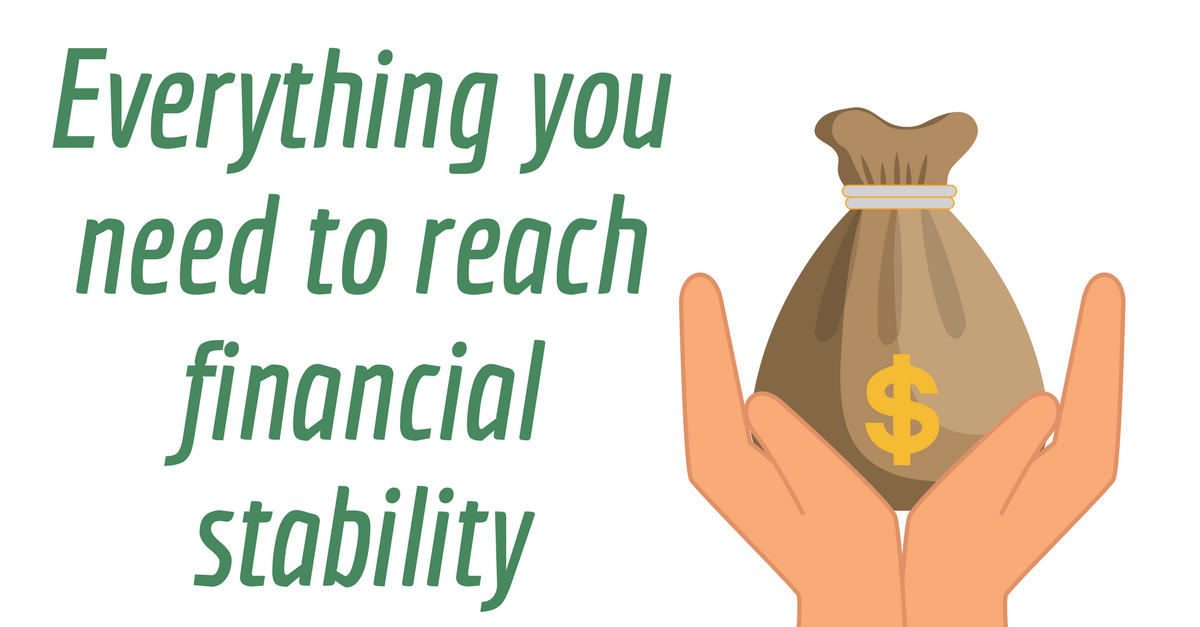Money isn’t everything. You can’t “buy happiness.” Yeah, yeah. We’ve all heard that one.
But you also can’t avoid the need for money. Whether we like it or not, money is king, and we have to accept its rule.

Our society runs on transactions and the flow of dollars. Need to pay rent or your mortgage? You need money. Water and electric bills? More money. Groceries, car payments, student loans? You get the idea.
Hooray capitalism!
None of this should be news to you, but I want to make sure we’re on the same page. Money is a tool we need to know how to use. The hard part is that it doesn’t come with a manual or instructions. However, it doesn’t take an investment banker or financial advisor to understand money.
Let me repeat: you do not need a finance background to understand money.
Although I have a degree in finance and work in the field, I honestly wasn’t financially literate until I researched and read about it.
Finance may be a challenging subject, but it doesn’t take too much effort to understand the basics.
Before we move on, let’s get some terms straight first.
- Financial Literacy: the use of knowledge to manage one’s finances. This is a skill and a lifestyle, not a status.
- Financial Stability: the possession of enough money to meet your needs. This is a status.
- Financial Abundance: the possession of more money than you need. This is also a status.
Keep these definitions in mind as you go on.
By reading this article, you are developing your financial literacy. You will then be able to use your financial literacy to become financially stable. If you maintain financial stability and use the lessons you learn here, you will reach financial abundance.
There’s a big difference between financial stability and financial abundance. If your money situation is stable, you consistently have enough to cover your needs. If you have an abundance of money, you have enough to cover all your needs and all of your wants with plenty leftover.
Obviously, financial abundance sounds more fun. Our wants matter too! However, unless you plan to win the lottery or inherit a large fortune, you won’t become an ultra-wealthy millionaire overnight. So you can’t be financially abundant until you are financially stable.
Plus, after you’ve established yourself as financially stable, you’ll gradually be able to afford more wants.
How to Reach Financial Stability

In order to achieve wealth, you have to start with the foundation.
When construction starts on a brand new skyscraper, they don’t start with the penthouse. They start with the foundation.
The same holds true for reaching financial stability and building wealth. You have to start from square one. Grab a shovel and break ground.
Sticking with the foundation theme, I like to refer to the following three steps to financial stability as “pillars”. Note that a budget or record of your monthly spending will make this process a lot easier. I wouldn’t say it’s mandatory, but it’ll ensure accuracy.
1. Short-Term Money (“STM”)
First, you need to build up a short-term reserve for everyday expenses, such as rent, gas, groceries, etc. There isn’t a universal dollar amount that applies to everyone. Why? Because expenses vary from person to person.
However, there’s a guideline you should follow. Your budget will come in handy here. Take your total monthly expense figure and multiply it by three. If your total monthly expenses are $2,000, multiply this by three, which equals $6,000.
Congratulations! You determined the least amount of money you should have at any given point. See, this is easy.
Why did you just do this? Because you want enough STM to cover three months worth of expenses, at least. This creates a short-term safety net. You’re not always going to meet your budget, there will be some months you spend more than you intended to. Maybe your favorite band is playing in your city, or your mom’s birthday is coming up and you want to get her a great gift (as you should).
This happens, don’t worry. Although you don’t want to make a habit of spending more than you planned, you also don’t want your budget to stop you from experiencing life.
Remember money doesn’t buy happiness? Yeah, you knew I’d find a plug for that somewhere.
Anyway, this safety net allows you to buy tickets to that concert or buy that gift. Without the financial stress.
Once you compile enough cash to meet three months worth of expenses, you can consider yourself liquid. You want to be liquid. If you are financially liquid, that means you have enough cash to cover your expenses.
The more expenses you have, the higher your STM reserve. The more volatile (or unpredictable) your lifestyle expenses, the higher your STM reserve.
Personally, I like to keep between three and four months worth of expenses in my checking account.
2. Emergency Money “EM”
Pillar two: expect the unexpected. We can’t predict our next fender bender or doctor visit. Sometimes life just hands us a lot at once. The best way to avoid future financial stress created by heavy-hitting bills is to stockpile emergency money.
Ever heard of rainy day funds? Pretty much the same thing.
EM is all about playing worst-case scenario. I’ve mentioned a couple random, high expense scenarios (car repairs, medical bills), but the worst-case scenario is no more income (i.e. no more job).
Why? Because as long as you’re making money, you can cut back on discretionary (voluntary in nature, not necessary) expenses to make up for unexpected money hits. But if you aren’t making any money, your STM and any other savings will get eaten up before you know it.
That’s where your EM comes into play. It’s established for exactly this type of scenario. Plus, it’s also easy to calculate! Take that same monthly expense total from before and multiply it by six. Using the same example, your EM will be $12,000 ($2,000 x 6).
You’ve now determined how much money you’d need to have stockpiled in order to last for six months without any income. In other words, if you lost your job or primary income source tomorrow, you’d have six months to find another.
You’re essentially “buying time”. I recommend choosing a time-frame you’re most comfortable with. Six months isn’t long enough? Build up that EM more. Confident in your ability to secure something faster? Props to you! But I still wouldn’t dip any lower than three months worth of expenses for your EM.
3. Long-Term Money “LTM”
Once you’ve established your STM and EM, you’ve effectively covered your short-term needs. But the fun doesn’t end there. Now it’s time to focus on your long-term security. The sooner you start saving for your future, the sooner compound interest can work its beautiful magic.
Compound interest is the result of putting your money to work.
I’ll use an example to explain compound interest. Let’s say you put $10,000 into a savings account today. This particular savings account has an interest rate of 5%, which means your $10,000 investment will grow at a rate of 5% each year. In other words, one year from now, your investment will be worth $10,500. Now here’s the beauty of compound interest. In year one, your investment grew from $10,000 to $10,500, or by $500. After year two, your investment will be worth $11,025, or $525 more. After year three, it’ll be up to a hair over $11,576, or $551 more. And so on, and so on.
See the pattern? The interest on your investment grows each year. After 20 years, that $10,000 investment will have grown to over $26,000. And that’s just leaving it untouched. If you consistently contribute $1,000 to this savings account each year for 20 years, your total investment will be worth about $60,000!
The rules of determining how much LTM you need are a little different from STM and EM. Rather than working towards a certain number of months worth of expenses, your LTM reserve will depend on your long-term goals.
If you’re trying to save for grad-school or a car or a house or any long-term investment, you’ll have to start contributing to your LTM reserve. A good starting point is to set aside 20% of your monthly income. If your post-tax income is $3,000 a month, 20% or $600 of that should be put in a savings or brokerage account.
Tying it all together
Let’s review using our earlier examples of $3,000 of net income and $2,000 of monthly expenses:
- Short-Term Money: about three months of expenses or $6,000
- Emergency Money: about six months of expenses or $12,000
- Long-Term Money: 20% of your monthly income or $600
Again, the idea is to build up each of these in the order they are listed. Once you’ve filled your reserves, proceed to the next.
I know building these financial pillars isn’t as simple as snapping your fingers. If you’re just graduating college or have been living paycheck-to-paycheck, it can be tough to get your foundation in place. But trust me, you’ll be so happy you did this now. The sooner you start building your foundation and erecting your financial pillars, the sooner you can kiss financial stress goodbye.
Plus, remember compound interest? It doesn’t take long for your efforts to start paying dividends. The sooner you get started, the more time your money has to grow.
After establishing these three pillars, your financial foundation will be stable! Your short-term outlook will be strong, as you become fit to handle expense volatility and any unforeseen money adversity. Your long-term goals will be one step closer to being accomplished, as you begin to actively contribute to your future. Looks like a wonderous skyscraper in the making!
I hope this has been helpful. I certainly wish I had known this information sooner. If you haven’t already, take a look at this post on financial literacy. Have any questions on any of the above topics? Comment below!



0 Comments